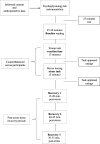Decreased reaction time variability is associated with greater cardiovascular responses to acute stress
- PMID: 26894967
- PMCID: PMC4855624
- DOI: 10.1111/psyp.12617
Decreased reaction time variability is associated with greater cardiovascular responses to acute stress
Abstract
Cardiovascular (CV) responses to mental stress are prospectively associated with poor CV outcomes. The association between CV responses to mental stress and reaction times (RTs) in aging individuals may be important but warrants further investigation. The present study assessed RTs to examine associations with CV responses to mental stress in healthy, older individuals using robust regression techniques. Participants were 262 men and women (mean age = 63.3 ± 5.5 years) from the Whitehall II cohort who completed a RT task (Stroop) and underwent acute mental stress (mirror tracing) to elicit CV responses. Blood pressure, heart rate, and heart rate variability were measured at baseline, during acute stress, and through a 75-min recovery. RT measures were generated from an ex-Gaussian distribution that yielded three predictors: mu-RT, sigma-RT, and tau-RT, the mean, standard deviation, and mean of the exponential component of the normal distribution, respectively. Decreased intraindividual RT variability was marginally associated with greater systolic (B = -.009, SE = .005, p = .09) and diastolic (B = -.004, SE = .002, p = .08) blood pressure reactivity. Decreased intraindividual RT variability was associated with impaired systolic blood pressure recovery (B = -.007, SE = .003, p = .03) and impaired vagal tone (B = -.0047, SE = .0024, p = .045). Study findings offer tentative support for an association between RTs and CV responses. Despite small effect sizes and associations not consistent across predictors, these data may point to a link between intrinsic neuronal plasticity and CV responses.
Keywords: Acute stress; Cardiovascular; Reaction times; Reactivity and recovery.
© 2016 The Authors. Psychophysiology published by Wiley Periodicals, Inc. on behalf of Society for Psychophysiological Research.
Figures



Similar articles
-
Three-year stability of cardiovascular and autonomic nervous system responses to psychological stress.Psychophysiology. 2014 Sep;51(9):921-31. doi: 10.1111/psyp.12231. Epub 2014 May 23. Psychophysiology. 2014. PMID: 24853995
-
A tale of two mechanisms: a meta-analytic approach toward understanding the autonomic basis of cardiovascular reactivity to acute psychological stress.Psychophysiology. 2014 Oct;51(10):964-76. doi: 10.1111/psyp.12248. Epub 2014 Jun 13. Psychophysiology. 2014. PMID: 24924500
-
Impact of a motivated performance task on autonomic and hemodynamic cardiovascular reactivity.Stress. 2016 May;19(3):280-6. doi: 10.1080/10253890.2016.1191467. Stress. 2016. PMID: 27295199 Clinical Trial.
-
Cardiovascular reactivity to mental stress is not affected by alpha2-adrenoreceptor activation or inhibition.Psychopharmacology (Berl). 2007 Feb;190(2):181-8. doi: 10.1007/s00213-006-0597-7. Epub 2006 Nov 17. Psychopharmacology (Berl). 2007. PMID: 17111173
-
Cardiovascular reactivity in real life settings: measurement, mechanisms and meaning.Biol Psychol. 2011 Feb;86(2):98-105. doi: 10.1016/j.biopsycho.2010.05.002. Epub 2010 Jun 1. Biol Psychol. 2011. PMID: 20561941 Free PMC article. Review.
Cited by
-
A Novel Approach to Assessment of Perceptual-Motor Efficiency and Training-Induced Improvement in the Performance Capabilities of Elite Athletes.Front Sports Act Living. 2021 Oct 1;3:729729. doi: 10.3389/fspor.2021.729729. eCollection 2021. Front Sports Act Living. 2021. PMID: 34661098 Free PMC article.
-
Cardiovascular reactions to acute psychological stress and academic achievement.Psychophysiology. 2022 Oct;59(10):e14064. doi: 10.1111/psyp.14064. Epub 2022 Mar 30. Psychophysiology. 2022. PMID: 35353904 Free PMC article.
-
Can Reactivity of Heart Rate Variability Be a Potential Biomarker and Monitoring Tool to Promote Healthy Aging? A Systematic Review With Meta-Analyses.Front Physiol. 2021 Jul 29;12:686129. doi: 10.3389/fphys.2021.686129. eCollection 2021. Front Physiol. 2021. PMID: 34393813 Free PMC article.
-
Cluster randomised controlled trial to investigate the effectiveness and cost-effectiveness of a Structured Health Intervention For Truckers (the SHIFT study): a study protocol.BMJ Open. 2019 Nov 24;9(11):e030175. doi: 10.1136/bmjopen-2019-030175. BMJ Open. 2019. PMID: 31767581 Free PMC article. Clinical Trial.
-
Self-Compassion and Psycho-Physiological Recovery From Recalled Sport Failure.Front Psychol. 2019 Jul 5;10:1564. doi: 10.3389/fpsyg.2019.01564. eCollection 2019. Front Psychol. 2019. PMID: 31333557 Free PMC article.
References
-
- Brage, S. , Brage, N. , Franks, P. W. Ekelund, U. , & Wareham, N. J. (2005). Reliability and validity of the combined heart rate and movement sensor Actiheart. European Journal of Clinical Nutrition, 59, 561–570. doi: 10.1038/sj.ejcn.1602118 - DOI - PubMed
-
- Brydon, L. , & Steptoe, A. (2005). Stress‐induced increases in interleukin‐6 and fibrinogen predict ambulatory blood pressure at 3‐year follow‐up. Journal of Hypertension, 23, 1001–1007. doi: 10.1097/01.hjh.0000166841.57474.d0 - DOI - PubMed
-
- Chida, Y. , & Steptoe, A. (2010). Greater cardiovascular responses to laboratory mental stress are associated with poor subsequent cardiovascular risk status: A meta‐analysis of prospective evidence. Hypertension, 55, 1026–1032. doi: 10.1161/HYPERTENSIONAHA.109.146621 - DOI - PubMed
-
- Coles, M. G. , Scheffers, M. K. , & Holroyd, C. B. (2001). Why is there an ERN/Ne on correct trials? Response representations, stimulus‐related components, and the theory of error‐processing. Biological Psychology, 56, 173–189. doi: 10.1016/S0301-0511(01)00076-X - DOI - PubMed
-
- Falkenstein, M. , Hoormann, J. , Christ, S. , & Hohnsbein, J. (2000). ERP components on reaction errors and their functional significance: A tutorial. Biological Psychology, 51, 87–107. doi: 10.1016/S0301-0511(99)00031-9 - DOI - PubMed
Publication types
MeSH terms
Grants and funding
LinkOut - more resources
Full Text Sources
Other Literature Sources
Medical
Research Materials

